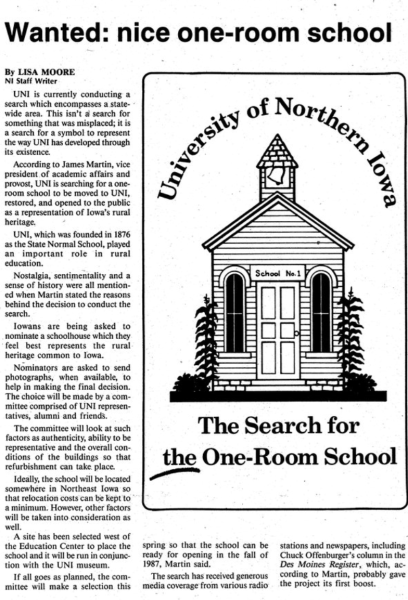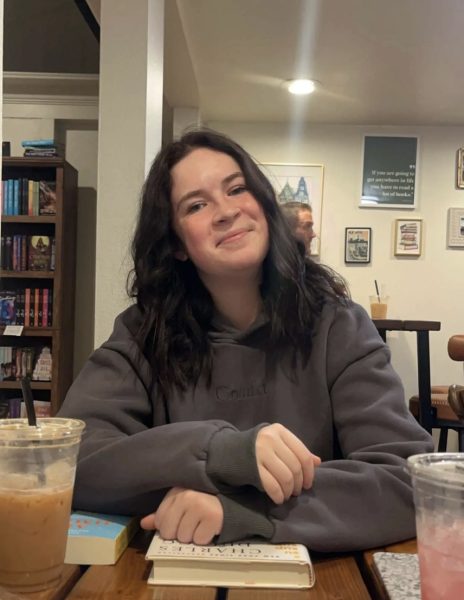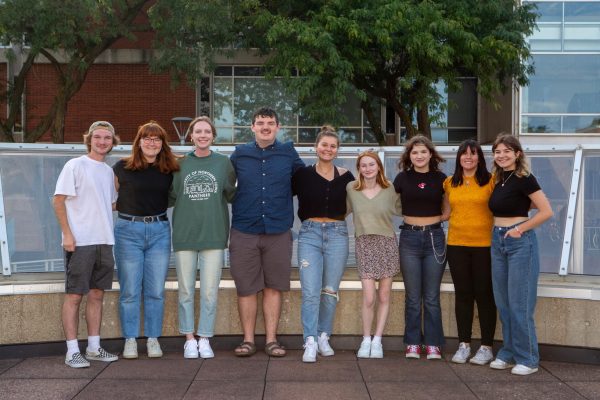At one point, Iowa had more than 12,000 one-room rural schoolhouses operating across the state. Now, only three remain in use. However, many of them have been restored and operate as museums to remember what education once looked like across the state. One of those schoolhouses is located right on the UNI campus behind the Schindler Education Center.
The Marshall Center School was built in 1893 and was originally located in Pocahontas County. It cost $730 to make this school, which at the time was very expensive. According to Nathan Arndt, director of the UNI Museum, the style of this school is very similar to other one-room schools but also has some uniqueness to it because it was from the East Coast. “Our school’s a little bit unique because it was built from a construction plan that was bought,” says Arndt. The school has two entrances, which Arndt believes were likely for male and female students as that was more common on the East Coast than in Iowa.
The interior of the Marshall Schoolhouse had several oddities to it. One is that the school has six windows, three on each side. “We can usually date schools by the amount of windows they have on there,” stated Arndt. At one point the state of Iowa had said that cross lighting was bad for students’ eyes, and so in many cases, one-room schools had no windows. However, Marshall still had its original windows until it was transported to UNI campus. Another oddity was the telephone installed in the school, which was installed in the 1930s. With the school being so far away from town, and tornadoes being very common in Iowa, the phone was installed so they could warn the school of a tornado. That same telephone still survives in the school today.
The school was open until 1944 but eventually converted into a voting center and stayed open until 1986 when the school officially closed to the community. By happenstance, at this time UNI was beginning the search to bring a rural school onto campus. “We’re a teacher’s college, and we always think about the teachers that came here, what they did,” stated Arndt. “It had criteria [to meet], the school had to have some connection back to UNI, and had to tell a story about Iowa education.”

In 1987, after meeting this criteria, Marshall School House was moved to the UNI campus. The school was then restored as close to what it once was in 1926, with the original wallpaper being duplicated as well as receiving a new roof, a new foundation and a new electrical system. Arndt feels that preserving the schoolhouse as it once was is crucial to show that idea of how education in Iowa once was. “Something we’re trying to do with the 150th anniversary being talked about … let’s look at what the teachers did after they left here, and the impact they had on the state and what that meant.”
In 1996 the school officially became part of the UNI museum and started incorporating interactive learning experiences. Groups of elementary students were brought to the school on field trips and authentic Christmas pageants from that time were hosted. The Friends of the UNI Museum, which was created in 1982 to support the work of the museum, played a very crucial role in bringing these events to life. It was also part of a collection at the museum, the rural school collection. “Part of the school’s consolidation was the records, the books, the documents, the photographs,” stated Arndt. “We have most of them … but we are still actively collecting. This showed where they [teachers] taught, how they taught, and the results of that teaching.”
However, in 2012 there were a lot of shutdowns across campus, including the campus museum. Due to these closures, the school sat stagnant for three years before Rod Library took over both the museum and the schoolhouse in 2015. Since then the museum has been trying to figure out how to use this space. “We’ve used it for exhibits, so we did a shared exhibit space with Silos and Smokestacks and opened the school for the public to come visit.” There are also several classes taught inside the schoolhouse including the museum studies certificate class where the class talks about managing historical structures and buildings, as well as education classes that have gone there to experience what it would be like to learn in that setting.
The museum has worked tirelessly over the years to restore the schoolhouse as accurately as possible while keeping it safe and up to date with modern requirements. When the school was moved to UNI, the campus helped pay for a brand-new cedar roof on it. The museum has also had an evaluator come and tell them exactly what needs to be done to make the building better. With the help of the UNI Friends group the museum has a priority list of remodels and renovations to bring the building to where it needs to be. This includes things like a new deck, new paint, and installing a full HVAC system to preserve the structure of the building.
Post-COVID has made it difficult for museum staff to figure out what to do with the schoolhouse, whether they want to preserve the school as it was in 1926 or integrate modern things like technology. “We’ve talked about doing events there, it’s hopefully going to be part of an architectural tour,” stated Arndt. Preservation methods and digital scanning have also been used, including a 3D tour of the school that was created by Jess Cruz, allowing people to explore the school digitally.
The schoolhouse serves as a reminder of what rural school education once was in Iowa. When the rural schools were shut down it was said that rural education was not as good as city education, however, they eventually discovered that this was not true. “They discovered that kids were actually farther ahead in their studies and that they had built strong communities.” Arndt believes that the values from rural schools are beginning to surface again, so making sure to preserve this history is more important than ever. In the future Arndt hopes that the Marshall Center School can be an open and active classroom again and that one day the school will be open to the public and for little to no cost have the opportunity to show past and future generations the history of education in Iowa.










